How to Get Naturally Glowing Skin at Home – Step-by-Step Guide for Lasting Results
When the lights go out, your body doesn’t just rest—your skin goes into healing mode. While you sleep, your skin works overtime to repair daily damage, boost collagen, and restore its natural barrier. This isn’t a marketing myth; it’s backed by science. Dermatologists call it the skin’s circadian rhythm—a biological cycle that follows the sun but repairs best at night.
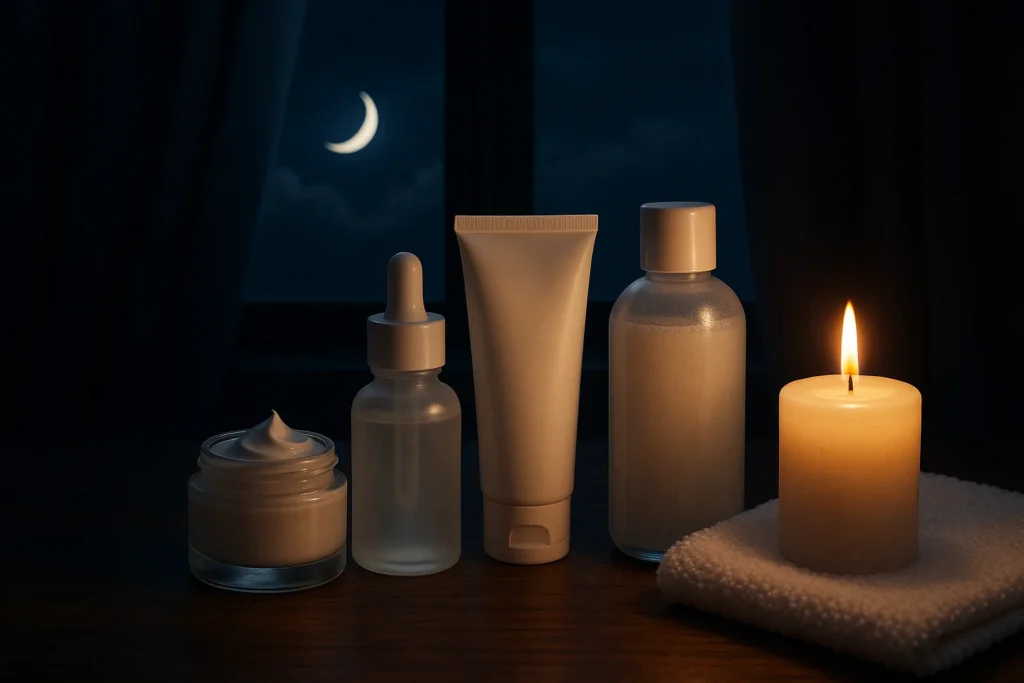
1. Why Night is the Best Time to Heal Your Skin
So if you’re still rinsing your face and jumping into bed, you’re missing out on the most powerful window for skin transformation. A targeted night skincare routine doesn’t just prevent aging—it actively repairs, hydrates, and balances your skin while you sleep.
🌙 Why Night Matters More Than Day
Unlike daytime skincare—which focuses on protection from UV rays, pollution, and makeup—nighttime skincare is about restoration. Think of your skin like a broken road: daytime routines set up cones and signs, but nighttime is when the actual repairs begin.
Studies show that:
- Cell regeneration peaks between 10 PM and 2 AM.
- Blood flow to the skin increases at night, improving nutrient delivery.
- Trans-epidermal water loss (TEWL) is higher during sleep, making hydration crucial.
This means your skin is more receptive to serums, masks, and active ingredients at night than any other time.
🔬 What Happens to Skin While You Sleep?
Here’s what your skin is busy doing while you’re dreaming:
- 🛠 Repairing Micro-Damage: UV, pollution, and internal stress take a toll. Night is when DNA repair enzymes are most active.
- 💧 Replenishing Moisture: Your skin loses more water at night, triggering its own hydration responses.
- 💆♀️ Collagen Production: Growth hormone released during sleep stimulates collagen and elastin, reducing fine lines over time.
If you pair this natural healing with a smart, consistent routine—you literally wake up glowing.
💥 Why Most People Waste This Golden Opportunity
Here’s the reality: most people either skip night care entirely or use random products with no order or consistency. But applying the wrong cream or layering ingredients incorrectly can interrupt your skin’s natural rhythm instead of supporting it.
This blog will show you 7 intentional, research-backed rituals that align with your skin’s biological clock. Whether you’re dealing with acne, dullness, dryness, or early aging—this is the daily 10-minute habit that can change everything.
2. Cleanse Without Stripping: Your Skin’s Reset Button

🌙 Your Night Skincare Starts Where the Day Ends
Your skin battles everything from UV rays and sweat to pollution and sunscreen throughout the day. But before you layer on luxurious serums and creams at night, there’s one rule you must follow: start with a clean, balanced canvas.
Yet here’s where most people go wrong: they either skip cleansing or overdo it with harsh foaming cleansers that leave the skin tight, dry, and vulnerable. Cleansing is not just a hygiene step—it’s your skin’s reset button. It tells your pores, “Okay, you’re safe now. Let’s heal.”
💧 Why Night Cleansing Is More Important Than Morning
While a morning rinse preps the skin for external stress, night cleansing removes internal and external impurities:
- Excess sebum produced during the day
- Sweat, dust, bacteria trapped in pores
- Makeup particles left behind (even after wipes!)
- SPF residues that can clog skin overnight
Without proper cleansing, these layers form a film over your skin—blocking serums from absorbing and encouraging breakouts, blackheads, and dullness.
🚫 Avoid These Cleansing Mistakes at Night
- Using High-pH Cleansers: These strip your skin’s natural acid mantle, which protects it from bacteria and inflammation.
- Over-exfoliating: Harsh scrubs can cause microtears and disrupt your skin barrier, especially at night when healing should be the focus.
- Relying on Makeup Wipes Alone: They leave behind residue and don’t truly clean the skin.
Skipping Double Cleansing (if you wear makeup or SPF): First oil-based, then water-based cleanser.
✅ What to Look For in a Gentle Night Cleanser
Your skin doesn’t need drama—it needs balance. A good night cleanser should cleanse deeply without stripping essential moisture.
🧴 Ideal Ingredients:
- Glycerin or Hyaluronic Acid: Hydrate while cleansing
- Chamomile or Green Tea Extract: Calm inflammation
- Lactic Acid or PHA (in low concentration): Gentle exfoliation
- Rice Water or Cucumber Extract: Brighten without irritation
🚫 Avoid:
- Sulfates (like SLS or SLES)
- Fragrance-heavy formulas
- Alcohol-based cleansers
💡 Best Night Cleansing Practices (for all skin types)
- Double Cleanse (for SPF/makeup users):
- Step 1: Oil-based cleanser to melt makeup/sunscreen
- Step 2: Water-based gel or cream cleanser to purify
- Step 1: Oil-based cleanser to melt makeup/sunscreen
- Use Lukewarm Water: Hot water can inflame the skin barrier.
- Massage, Don’t Scrub: Spend at least 60 seconds massaging your cleanser—this increases blood flow and softens clogged pores.
- Pat Dry with a Soft Towel: Rubbing causes friction and irritation.
🌿 Recommended Gentle Cleansers (Safe + Natural)
(You can replace this with affiliate links or internal reviews later)
- CeraVe Hydrating Cleanser (dry/normal skin)
- Simple Kind to Skin Refreshing Cleanser (sensitive skin)
- The Ordinary Squalane Cleanser (all skin types)
DIY Option: Mix raw honey + aloe vera gel as a soothing natural cleanser
🧠 The Psychology Behind Night Cleansing
Cleansing isn’t just physical—it’s symbolic. You’re washing off not just dirt but the stress, energy, and buildup of the day. When you make this step intentional, your entire skincare ritual becomes meditative. That alone contributes to reduced stress levels—which, guess what?—shows up as clear, calm skin.
3. Hydration First: Toners That Calm, Not Sting
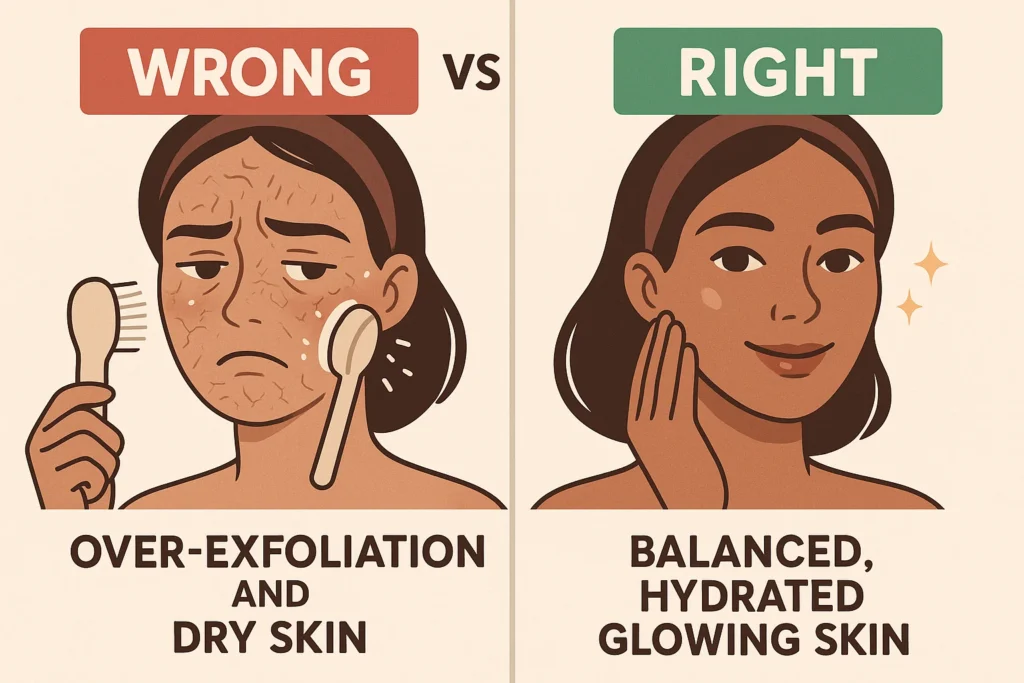
💧 Toner Isn’t Optional — It’s the First Step to Hydration
Let’s bust an old skincare myth right now: “Toners are just fancy water.”
Wrong. In fact, in a well-structured night skincare routine, toner is your skin’s first sip of hydration after cleansing—the reset that tells your pores, “Time to soak in the good stuff.”
But here’s the catch: most people are still using astringent alcohol-based toners that sting, dry out the skin, and disrupt the skin barrier. The right toner should calm, hydrate, and prep your skin—not make it feel like it’s being punished.
🧪 What Exactly Does a Toner Do?
Toners are liquid formulas that:
- Balance your skin’s pH after cleansing
- Remove leftover cleanser residue
- Soothe irritation or inflammation
- Deliver light hydration and prep skin for serums
- In some cases, provide mild exfoliation
At night, when your skin is in healing mode, a hydrating toner acts like a primer for everything that follows—it makes your serums more effective and your moisturizer more absorbable.
❌ Skip the “Sting” – Ingredients to Avoid in Toners
Old-school toners with alcohol, witch hazel, or artificial fragrance can:
- Trigger sensitivity
- Cause tightness and dehydration
- Exacerbate redness and acne
Look at the label. If alcohol (especially denatured or SD-alcohol) is one of the first five ingredients, put it back.
✅ Hydrating & Soothing Ingredients to Look For
To get the calming and restorative effect you need at night, look for these power-packed ingredients:
| Ingredient | Skin Benefit |
| Rose Water | Soothes, reduces redness |
| Hyaluronic Acid | Deep hydration, plumps skin |
| Glycerin | Locks in moisture |
| Aloe Vera | Cools and heals irritated skin |
| Green Tea Extract | Antioxidant, fights inflammation |
| Cucumber Extract | Refreshes and tightens without drying |
| Panthenol (B5) | Repairs and strengthens the skin barrier |
🌙 How to Apply Toner at Night (The Right Way)
- Post-Cleansing, Pat Skin Dry: Don’t let your face completely dry before applying toner. Slightly damp skin increases absorption.
- Use Hands, Not Cotton Pads: Pour a few drops into your palms and press gently into the skin.
- Wait 30 Seconds: Allow your toner to absorb fully before moving to serums.
Optional Second Layer: For extra hydration, apply two light layers (“7-skin method” is popular in K-beauty).
🧴 Best Night-Time Toners by Skin Type
- Dry Skin:
- Klairs Supple Preparation Toner
- Pyunkang Yul Essence Toner
- Klairs Supple Preparation Toner
- Oily/Acne-Prone Skin:
- COSRX AHA/BHA Clarifying Toner
- Benton Aloe BHA Skin Toner
- COSRX AHA/BHA Clarifying Toner
- Sensitive Skin:
- Thayers Alcohol-Free Rose Petal Toner
- Simple Soothing Facial Toner
- Thayers Alcohol-Free Rose Petal Toner
DIY Natural Option:
Mix rose water + a drop of glycerin for an instant, calming, budget-friendly toner.
🧘♀️ The “Hydration Cascade” Explained
Here’s the real trick to glow: hydration works in layers, like a sponge absorbing water. A good toner adds the first soft layer, allowing heavier ingredients like serums and creams to absorb more evenly. Without toner, you’re essentially applying expensive products on dehydrated, tight skin that can’t take full advantage.
4. Serums That Work While You Sleep
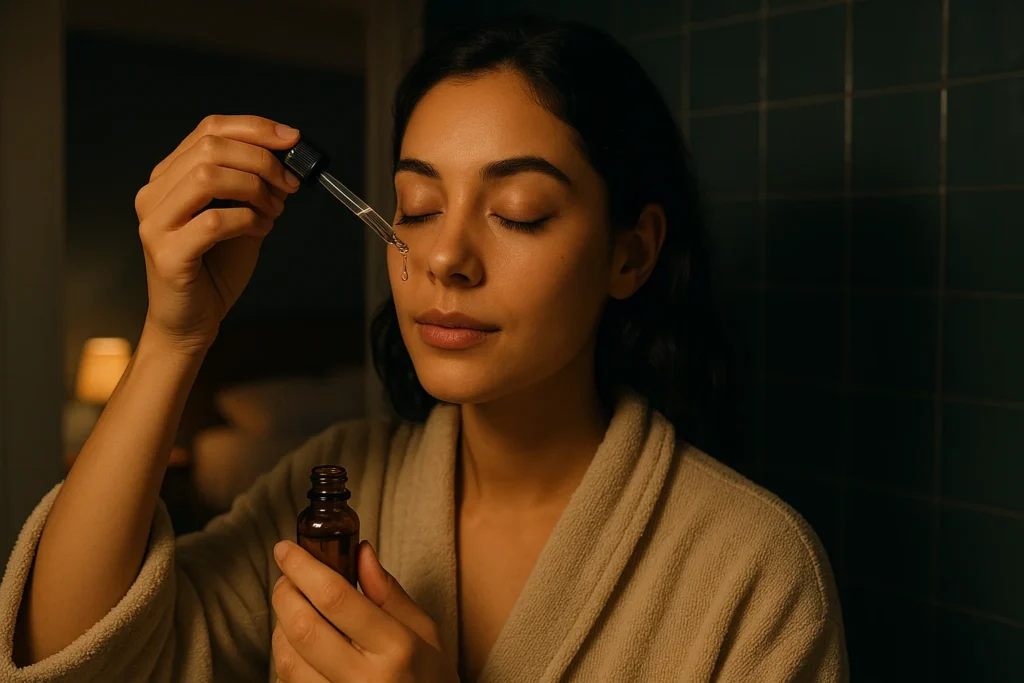
🌌 Serums: The Real Power Players of Your Night Routine
If your skincare routine were a team, serums are the star players—lightweight, targeted, and packed with high concentrations of active ingredients. Especially at night, when your skin’s barrier is more permeable and cell regeneration is at its peak, applying the right serum can lead to noticeable results overnight.
But here’s the twist: most people either skip serums or use the wrong one for their skin type and time of day. A night serum should focus on repairing, hydrating, and brightening—not just offering temporary plumpness.
🧬 Why Nighttime is Ideal for Active Ingredients
When you sleep, your body shifts into recovery mode. This biological rhythm supports:
- Increased cell turnover
- Better absorption of actives
- Fewer external pollutants interfering with skin
- Lower cortisol levels, which means less inflammation
That’s why night serums can safely include stronger ingredients like retinol, peptides, niacinamide, or vitamin C derivatives, which may be too intense for daytime use due to sun sensitivity.
🌟 Best Night Serums by Skin Goal
Let’s break it down by what you want your skin to do while you sleep.
✅ 1. For Glowing & Even-Toned Skin
Use: Niacinamide + Vitamin C (SAP or MAP form at night)
Benefits: Brightens dull skin, reduces pigmentation, boosts radiance
Examples:
- The Ordinary Niacinamide 10% + Zinc 1%
- Klairs Freshly Juiced Vitamin Drop (gentle Vit C)
✅ 2. For Acne-Prone or Oily Skin
Use: BHA (salicylic acid) or tea tree extract
Benefits: Unclogs pores, controls sebum, reduces inflammation
Examples:
- Paula’s Choice BHA Liquid Exfoliant
- Cos De BAHA Salicylic Acid Serum
✅ 3. For Dry or Dehydrated Skin
Use: Hyaluronic Acid + Panthenol + Peptides
Benefits: Deep hydration, skin repair, smoother texture
Examples:
- The Inkey List Hyaluronic Acid
- Dr. Jart+ Peptidin Serum
✅ 4. For Anti-Aging / Fine Lines
Use: Retinol + Peptides + Squalane
Benefits: Stimulates collagen, reduces wrinkles, firms skin
Examples:
- The Ordinary Retinol in Squalane
- L’Oreal Revitalift Night Serum
✅ 5. For Sensitive Skin
Use: Centella Asiatica, Madecassoside, Beta-Glucan
Benefits: Reduces redness, strengthens barrier, soothes irritation
Examples:
- Skin1004 Centella Ampoule
- Etude House Soon Jung Repair Serum
🧴 How to Layer Night Serums Properly
Many users waste powerful products by misapplying them. Here’s a foolproof guide:
- Apply after toner (on slightly damp skin)
- Use 3–5 drops, press into skin—not rub
- Wait 1 minute before layering another product
- If using multiple serums: Layer from lightest to thickest texture
- Always follow with a night moisturizer to lock it in
💡 Pro Tip: Less Is More
Using too many actives (like Vitamin C + Retinol + BHA together) can backfire. Stick to 1–2 serums max per night and alternate actives on different days to avoid irritation.
Example Routine:
- Day 1: Niacinamide + Hyaluronic Acid
- Day 2: Retinol only
Day 3: Centella + Peptides
🧠 Why Serums Show Results Faster at Night
Night serums are not “quick fixes.” But because your skin isn’t battling UV rays, dirt, and constant touch, it has a better environment to absorb nutrients and repair itself. Most users report a visible improvement in texture, clarity, and glow within 7–14 days of consistent use.
5. Moisturizers That Seal & Heal Overnight

🧴 Why Night Moisturizers Matter More Than You Think
Moisturizer is often treated like the “last step” in skincare—an afterthought. But in reality, it’s your skin’s overnight bodyguard. It locks in hydration, prevents transepidermal water loss (TEWL), and delivers active ingredients while you sleep.
At night, your skin goes into deep repair mode. This is when collagen synthesis, cell turnover, and barrier recovery are most active. If you skip moisturizer—or use the wrong one—you’re essentially leaving your skin vulnerable at its most sensitive hour.
🌙 What Makes a Moisturizer “Right” for Night?
Day moisturizers are often lighter, focused on protection (think SPF, antioxidants).
Night moisturizers, however, should be:
- Thicker in consistency
- Rich in occlusives (like ceramides, squalane, or shea butter)
- Packed with repair-driven actives
- Free of irritating fragrances or alcohols
Most importantly, they should support the skin barrier, not just “feel nice.”
🧪 Key Ingredients to Look For
Here’s what makes a great night moisturizer truly effective:
| Ingredient | Function |
| Ceramides | Rebuild skin barrier |
| Peptides | Boost collagen, repair skin damage |
| Squalane | Mimics skin’s natural oils, deep moisture |
| Niacinamide | Brightens, reduces inflammation |
| Centella Asiatica | Soothes irritation, boosts healing |
| Shea Butter | Occlusive, seals hydration |
| Hyaluronic Acid | Hydration magnet |
| Panthenol (B5) | Skin barrier repair + hydration |
These aren’t just buzzwords—they’re clinically studied actives proven to work best while your body rests.
🛌 Best Night Moisturizers by Skin Type
To truly “seal and heal,” your product has to match your skin’s needs.
✅ 1. Dry Skin
- Needs: Deep hydration, barrier restoration
- Try:
- CeraVe PM Facial Moisturizing Lotion
- First Aid Beauty Ultra Repair Cream
- The Ordinary Natural Moisturizing Factors + HA
- CeraVe PM Facial Moisturizing Lotion
✅ 2. Oily or Acne-Prone Skin
- Needs: Lightweight hydration, non-comedogenic, calming
- Try:
- Neutrogena Hydro Boost Water Gel (fragrance-free)
- CosRx Centella Blemish Cream
- La Roche-Posay Effaclar Mat
- Neutrogena Hydro Boost Water Gel (fragrance-free)
✅ 3. Sensitive or Reactive Skin
- Needs: Fragrance-free, minimal ingredients, barrier support
- Try:
- Vanicream Moisturizing Cream
- Avene Skin Recovery Cream
- Vanicream Moisturizing Cream
Etude House Soon Jung 2x Barrier Intensive Cream
✅ 4. Dull or Uneven-Toned Skin
- Needs: Brightening, hydration, texture smoothing
- Try:
- Olay Regenerist Night Cream
- Glow Recipe Banana Soufflé Moisture Cream
- Olay Regenerist Night Cream
Klairs Midnight Blue Calming Cream
🧘♀️ How to Apply Moisturizer for Maximum Overnight Results
Here’s your ideal layering strategy after toner and serum:
- Warm a small amount between your hands
- Press gently into the skin, don’t rub
- Focus on dry areas (cheeks, jaw, forehead)
- For extra dry skin, apply a second layer or “slug” with a thin layer of squalane or Vaseline
🔁 Pro Tip: Consistency beats quantity. Using a quarter-sized amount of the right moisturizer every night will outperform expensive creams used once a week.
🔍 Signs Your Moisturizer Is (or Isn’t) Working
Good signs:
- Skin feels hydrated even after waking up
- No tightness or flaking
- Smooth texture and bounce
- Improved glow over time
Red flags:
- Skin feels greasy or sticky in the morning
- New breakouts or redness
- Stinging on application
🧠 The Science of “Sealing In”
Moisturizers with occlusive agents like dimethicone, shea butter, or petrolatum create a breathable layer on the skin, locking in the benefits of your toner and serum. Without it, moisture evaporates overnight, leading to dry, dull, or flaky skin—even if your routine is perfect.
6. Weekly Add-ons: Masks, Exfoliants & Oils That Supercharge Your Glow
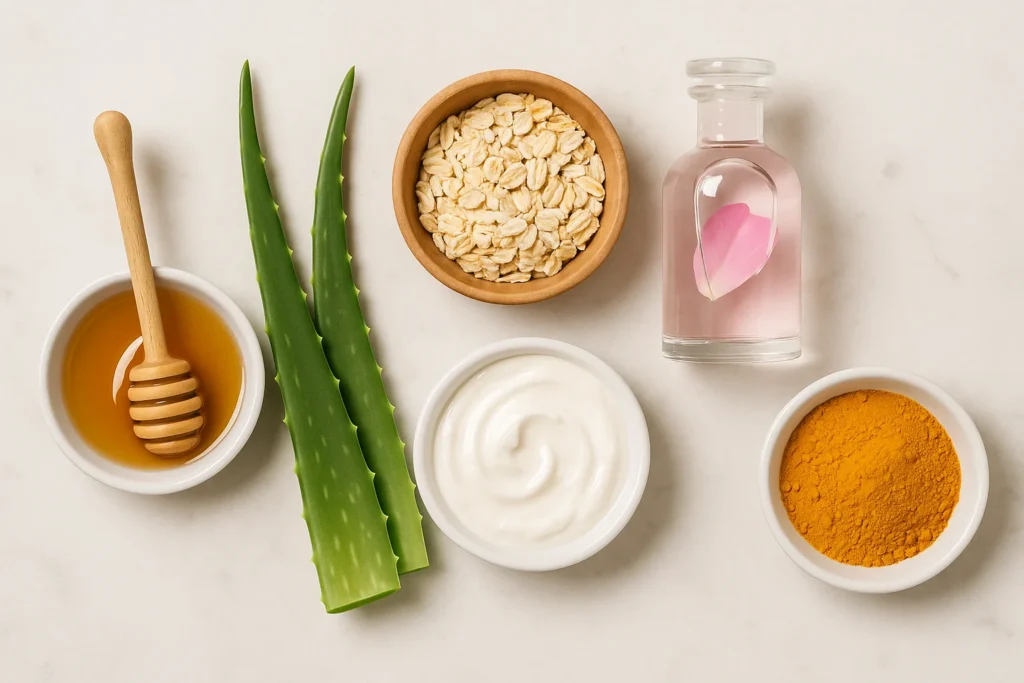
🔁 Why Weekly Treatments Are the Secret to Long-Term Glow
Even with a solid daily skincare routine, your skin needs occasional deep care. That’s where weekly add-ons come in. Think of them as the power-ups in your skincare game—used 1–2 times a week to reset, boost, and renew your skin.
These include:
- Face Masks (hydrating, detoxifying, brightening)
- Exfoliants (chemical or physical)
- Facial Oils (nourishing and barrier-supporting)
Using them strategically, not excessively, can dramatically improve texture, tone, and radiance over time.
🧼 Exfoliation: Out With the Old, In With the Glow
Exfoliation is about removing dead skin cells, which dull your complexion and block actives from penetrating. But overdoing it can backfire, causing sensitivity and breakouts.
✅ Best Types of Exfoliants for Weekly Use:
| Type | Good For | Frequency |
| AHA (Glycolic, Lactic) | Dull, dry skin, pigmentation | 1–2x/week |
| BHA (Salicylic Acid) | Oily, acne-prone skin | 1–2x/week |
| Enzymatic (Papaya, Pumpkin) | Sensitive skin | 1–2x/week |
| Physical (Rice, Sugar Scrub) | Non-sensitive skin (occasional) | 1x/week |
Examples:
- The Ordinary AHA 30% + BHA 2% Peeling Solution
- Paula’s Choice 2% BHA Liquid
- Wishful Yo Glow Enzyme Scrub
⚠️ Never combine exfoliants on the same day as retinol or strong acids. Alternate days for skin safety.
🎭 Face Masks: Instant Fixes, Long-Term Benefits
Face masks provide a concentrated dose of active ingredients. Depending on your skin type, rotate between:
🧴 Hydrating Masks
- Ingredients: Hyaluronic Acid, Aloe Vera, Honey
- Ideal for: Dry, dehydrated, sensitive skin
- Frequency: 2x/week
Examples: - Laneige Water Sleeping Mask
- I’m From Honey Mask
🧼 Detoxifying or Clay Masks
- Ingredients: Kaolin, Bentonite Clay, Charcoal
- Ideal for: Oily, acne-prone skin
- Frequency: 1x/week
Examples: - Aztec Indian Healing Clay
- Innisfree Super Volcanic Pore Clay Mask
🌟 Brightening Masks
- Ingredients: Vitamin C, Niacinamide, Turmeric
- Ideal for: Dull or uneven skin tone
- Frequency: 1–2x/week
Examples: - GlamGlow Flashmud
- Sand & Sky Australian Pink Clay Mask
Application Tip: Apply after cleansing, leave for 10–15 mins, rinse with lukewarm water, follow with toner and moisturizer.
💧 Facial Oils: Seal the Deal With Nourishment
Oils are lipid-rich emollients that not only moisturize but also deliver antioxidants, essential fatty acids, and skin-repairing nutrients.
They’re ideal for PM use once or twice a week, especially when skin feels dry, irritated, or weather-stressed.
✅ Best Facial Oils by Skin Type:
| Skin Type | Recommended Oils |
| Dry & Mature | Rosehip, Argan, Marula |
| Oily/Combination | Squalane, Jojoba, Grapeseed |
| Sensitive | Calendula, Sea Buckthorn, Moringa |
🔁 Pro Tip: Mix 2–3 drops of oil into your night cream or apply as the final step after moisturizer.
🧘 How to Structure Your Weekly Add-On Schedule
Here’s a flexible weekly planner you can adapt:
- Monday: Hydrating Mask
- Wednesday: AHA/BHA Exfoliation
- Friday: Brightening or Detox Mask
- Sunday: Facial Oil massage or overnight mask
Note: If your skin feels irritated, skip actives and use only calming products that day.
7. FAQs
❓ What is the fastest way to get glowing skin at home?
The fastest way to get glowing skin at home is by following a 3-step routine: gentle exfoliation, applying a hydrating face mask (like honey and aloe vera), and finishing with a few drops of rosehip or squalane oil. This boosts blood flow, removes dead skin cells, and deeply nourishes your skin—often revealing visible glow in just one use.
Tip: Avoid harsh scrubs or bleach creams. Natural, layered hydration works faster and safer.
❓ Are DIY face masks effective for all skin types?
Yes, when chosen carefully. Oily skin benefits from clay-based masks (like bentonite), dry skin from hydrating masks (with honey or yogurt), and sensitive skin from calming ones (with oats or aloe vera). The key is to use ingredients that match your skin’s sensitivity, pH, and oil balance.
❓ How often should I exfoliate my skin for a healthy glow?
Exfoliating 1–2 times per week is ideal. Over-exfoliation can damage your moisture barrier, leading to breakouts and dullness. For glowing skin, use chemical exfoliants like glycolic or lactic acid if you want even results without scrubbing.
Rule: If your skin stings, feels tight, or flakes—scale back.
❓ Can I use a moisturizer and facial oil together at night?
Absolutely. In fact, combining them enhances results. First, apply your regular night moisturizer, then seal it with 2–3 drops of facial oil. This method, called “moisture layering”, locks in hydration and boosts skin repair overnight.
❓ Which ingredients should I avoid in DIY skincare?
Avoid lemon juice (too acidic), baking soda (too alkaline), and raw egg (bacterial risk). Also skip cinnamon or toothpaste—they can cause chemical burns. Instead, use safe alternatives like turmeric, yogurt, oats, honey, aloe vera, or rose water.
❓ Do overnight masks actually work?
Yes. Overnight masks are formulated to work in sync with your skin’s circadian rhythm. While you sleep, skin cells regenerate, and overnight masks support barrier repair, hydration, and active absorption. Choose masks with ingredients like hyaluronic acid, niacinamide, or peptides for best results.
❓ Is glowing skin a sign of healthy skin?
Yes. Natural glow is often an external indicator of hydrated, balanced, and inflammation-free skin. However, glow can also be faked temporarily with oils or highlighters, so it’s essential to focus on long-term health through a consistent skincare routine, nutrition, and stress management.
❓ How long does it take to get visible results from home remedies?
You may notice minor improvements after 1–2 weeks of consistency, but true skin transformation takes 4–6 weeks. This is the average skin renewal cycle. Stick to natural remedies, stay hydrated, and avoid switching products too frequently.
❓ What is the best night routine for glowing skin?
Here’s a simple night routine:
- Cleanse with a gentle face wash
- Apply toner or rose water
- Use a serum (like niacinamide or hyaluronic acid)
- Moisturize generously
- Add a facial oil or sleeping mask
Bonus: 1–2 times a week, add a clay or brightening mask before serum.
❓ Is it safe to use facial oils on oily or acne-prone skin?
Yes—non-comedogenic oils like jojoba, squalane, or grapeseed oil are ideal for oily skin. They regulate sebum production and offer antioxidant protection without clogging pores. Avoid heavy oils like coconut or olive oil if you’re acne-prone.
8. Glow is a Habit, Not a Miracle
Glowing skin isn’t magic — it’s method. There’s no “one miracle product” or secret kitchen recipe that transforms your skin overnight. The truth? Radiance is built slowly through mindful habits, tailored choices, and consistent care. It’s what you do every day — and every week — that shapes your skin’s tone, texture, and vitality.
Let’s break down what that really means.
✨ The Skin You Have Is the Skin You Build
Whether you have dry, oily, combination, or sensitive skin — your skin is a living, breathing organ that responds to its environment. It adapts. It reacts. It heals. And most importantly: it thrives when given the right support. That support doesn’t always come from expensive brands or fancy ingredients — it often comes from understanding what your skin actually needs, and delivering it with consistency.
🧴 Product Hopping ≠ Progress
One of the biggest reasons most people don’t get results? They switch routines too fast. Glow doesn’t show up when you’re constantly trying a new scrub one day, a serum the next, and a face pack you saw on TikTok three hours later.
Your skin needs time to adapt and absorb. It takes about 28–40 days for your skin cells to fully renew — that’s your minimum commitment window to test what works.
Stick with a core routine:
- Gentle cleanser
- Nourishing moisturizer
- Sun protection in the day
- Targeted treatment at night
- Weekly mask/exfoliant/oil boost
No skipping. No rushing. No panicking over a pimple.
🕒 Consistency + Patience = Lasting Glow
There’s a reason top dermatologists say, “The best skincare product is the one you’ll use every day.” Because habits matter more than hype. When you hydrate every morning, cleanse before bed, eat antioxidant-rich foods, and sleep 7–8 hours, you’re telling your skin: I’ve got your back.
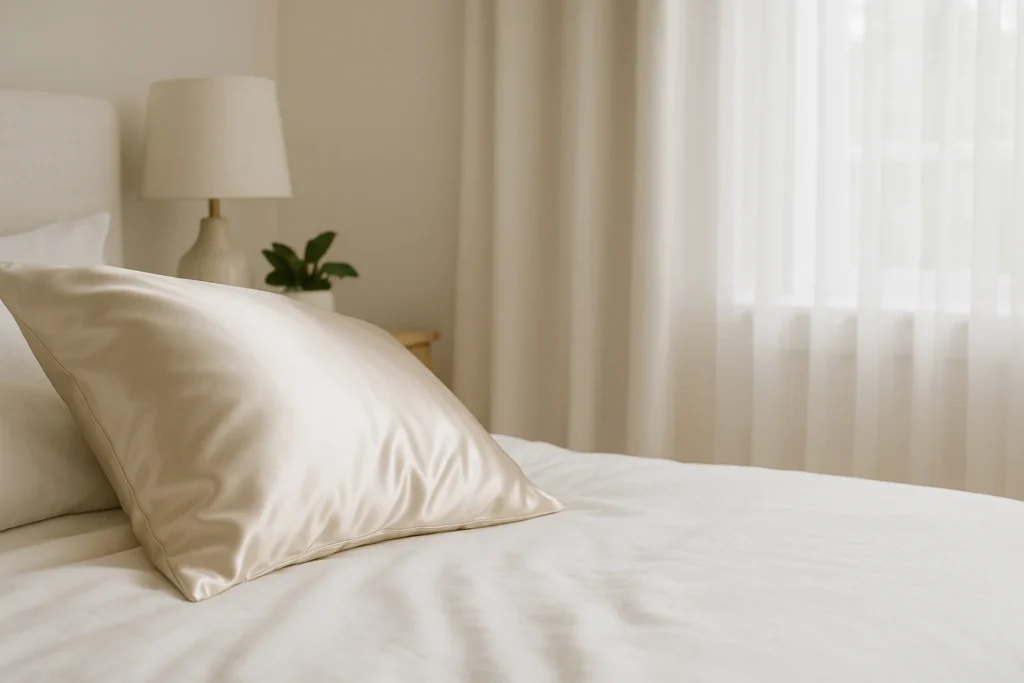
Even the best skincare can’t compete with poor diet, dehydration, stress, and sleep deprivation. Glowing skin is holistic. It’s a combination of:
- External care (products, protection)
- Internal support (nutrition, hormones, hydration)
- Emotional balance (stress shows on your skin)
🧘 It’s a Ritual, Not a Race
The biggest beauty shift you’ll make is viewing skincare as self-care, not self-correction. Your face is not a problem to fix — it’s a reflection to nourish. Whether you’re mixing a DIY mask, massaging oil into your cheeks, or applying sunscreen on a cloudy day — treat it as a ritual, not a routine.
Slow glow > fast fix. Always.
💡 What You Should Remember
- Don’t chase glow, build it.
- Hydration, rest, nutrition, and sunscreen are non-negotiable.
- Be gentle — to your skin and to yourself.
- Trust the process. The mirror will reward you.
You don’t need miracles.
You need mindfulness.
And once you commit, the glow becomes your natural state — not a goal.

